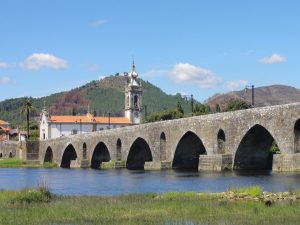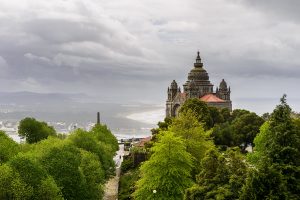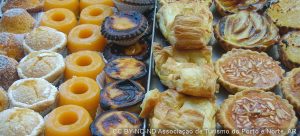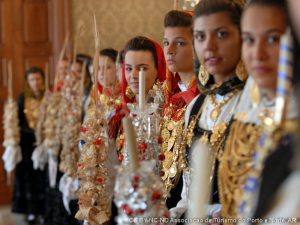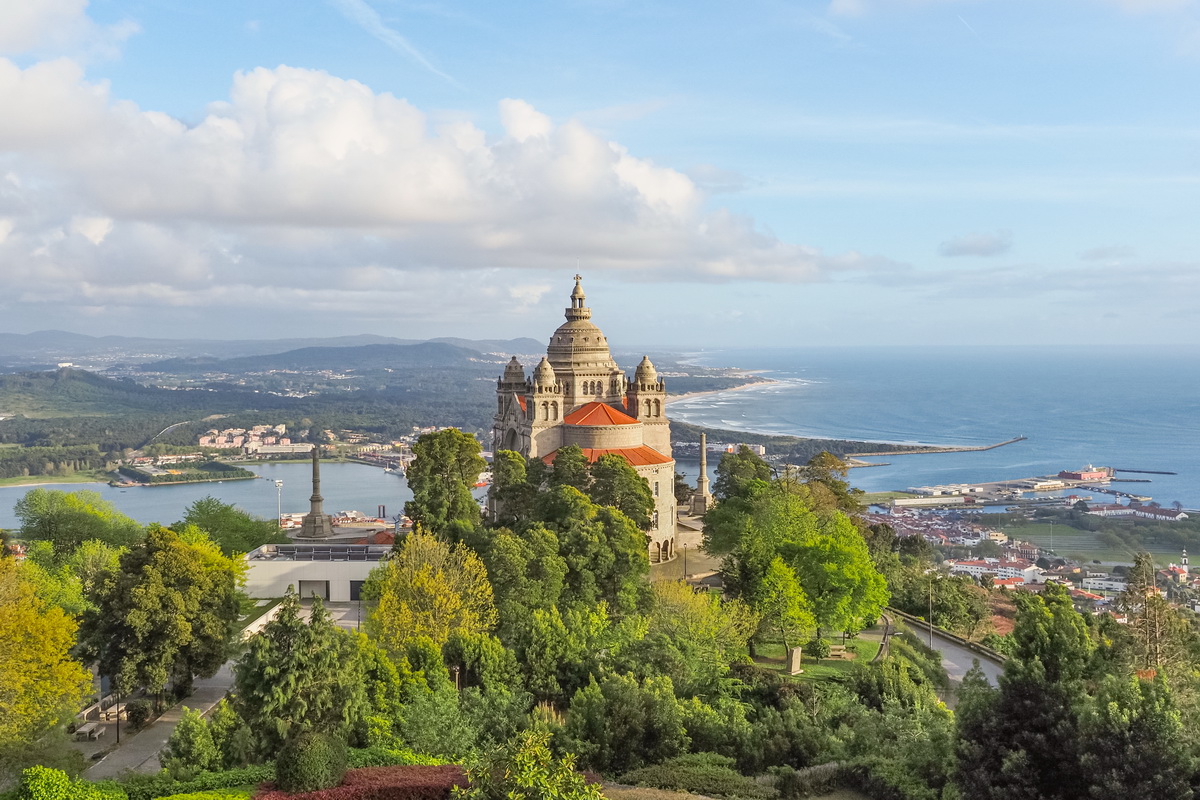
There are so many things to see and do in the Minho Region we usually recommend at least 4/6 nights (split into two or three centres) whether on a short trip or as part of a broader tour around Portugal – click here for more details about our Portuquese itineraries. Here’s our guide covering all the Minho Region´s highlights…
Minho Region – A land of greens
Tucked cosily into the far north-west corner of Portugal, bordered by Spain and the Rio Minho to the north, the dramatic Atlantic coast to the west and the granite mountains of Tras Os Montes to the east, the delightful relatively undiscovered region of the Minho is a land of strikingly intense greens – from its lush and verdant river valleys and extensive vineyards to its stunningly green “caldo verde” soup and its deliciously sharp and fruity “vinho verde” wine!
Historic cities, charming towns and more…
Birthplace of the Portuguese kingdom and home to some of Portugal’s most important and ancient cities and towns. Roman Braga, medieval Guimaraes, graceful Ponte de Lima, the elegant sea port of Viana do Castelo – well preserved Roman, Romanesque, Gothic, Renaissance and Baroque architecture mixes with state-of-the-art modern. Add fortress towns, beautiful parks and gardens, wine estates, imposing manor houses, impressive religious monuments, fantastic archaeological sites, colourful markets, festivals and processions, warm and hospitable people and you are beginning to get the full picture…
Stunning natural beauty
An area of outstanding natural beauty and traditions, a quiet stroll or bike ride along any of the tree-lined rivers is a must. The National park of Peneda-Geres, with its remote mountain villages where farming methods remain unchanged, is stunning and excellent for hiking or gentle walking. The wonderful windswept beaches, particularly at Caminha and Ancora, are a surfer’s dream while the fluvial beaches on the Minho and Lima a pleasure for all the family.
Table of Contents
Minho Region Highlights – 6 things to see and do in the Minho Region
- Braga
- Guimaraes
- Ponte de Lima and the Lima Valley
- Viana Do Castelo
- Parque Nacional da Peneda-Geres
- Vinho Verde – a true green delight!
Things to See and Do in the Minho Region – Out and About
- Valenca do Minho
- Moncao
- Melgaco
- Soajo
- Caminha
- Vila Nova de Cerveira
- Atlantic Beaches and Praias Fluviais
- Serra D’Arga
- River walks along the Rio Vez and Rio Lima
- Thursday market at Barcelos
- Bom Jesus do Monte
- Citania de Briteiros
- The Monastery of Tibaes
- Albufeira de Canicada
Practicalities – Frequently asked questions about things to see and do in the Minho Region
Minho Region Highlights
Braga
Bracara Augusta – capital of Roman Galicia
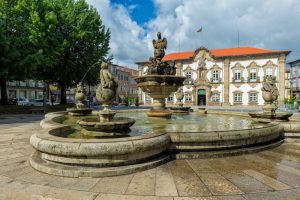
Dating back 2000 years, “Bracara Augusta” was the capital of Roman Galicia, but after several destructive invasions it was rebuilt in C11th by Bishop Pedro who established it as one of the most important religious centres in the Iberian Peninsula. The magnificent Se (cathedral) with its Sacred Art Museum stands in evidence of such an inheritance, and you could well make it the start of your exploration of this fascinating city.
And on the outskirts are yet more sights to visit and marvel at– the religious sanctuary of Bom Jesus, the baroque monastery of Tibaes, the pre Romanesque chapel of Sao Fructuoso…
It’s a university town and there is always something going on, but it is particularly atmospheric in Semana Santa, with elaborate Easter celebrations, and in June, when the Festas de Sao Joao (John the Baptist) include medieval folk plays, processions, bonfires, fireworks and basil! (the symbol of Sao Joao).
Guimaraes
“The cradle of Portugal”
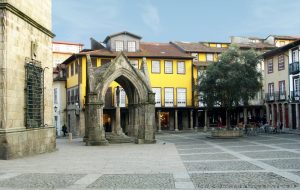
Cultural events and festivities crowd the calendar, but the city is undoubtedly at its liveliest for Festas de Cidade e Gualterianas (a fiesta dating back to 1452, held in honour of its patron saint), the first weekend of August, and for its jazz festival during most of November!

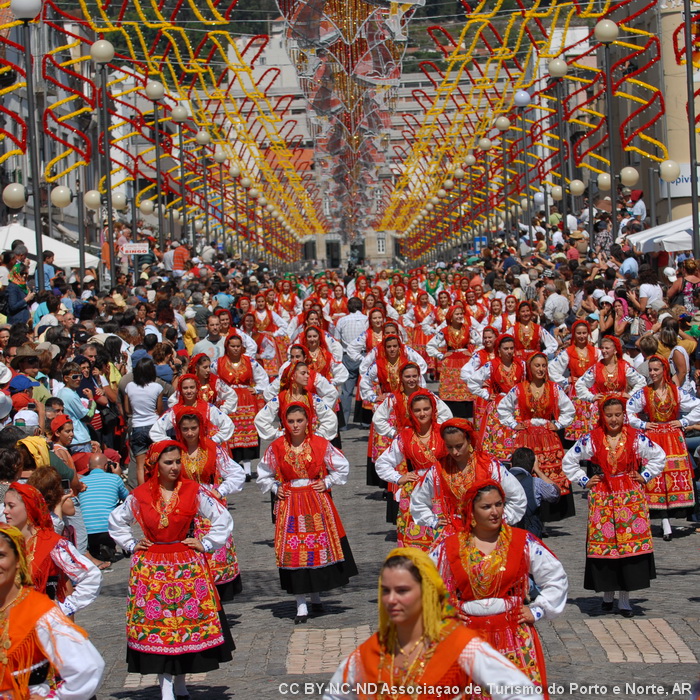
Ponte de Lima and the Lima Valley
Oldest town in Portugal
In the heart of the lush Lima valley with vineyards all around, Ponte de Lima, the oldest town in Portugal and also known as its most floral, sits gracefully on the romantic Rio Lima with its fine medieval bridge, originally built by the Romans, spanning the river.
At one time the main commercial route from Braga to Astorga in Spain, today thousands of pilgrims still cross the bridge on their way to Santiago de Compostela. It is a very pretty town with a small historic centre, beautiful parks and gardens, remains of medieval walls, manor houses and palaces, some eyecatching “azulejos” (painted tiles) depicting local history, street side cafes overlooking the river, a good choice of restaurants serving local dishes and a toy museum!
Nicely laid back in feel, it does get busy at weekends and at its vast fortnightly Monday market when stalls spread themselves all along the river banks. Crowds also descend for the horse fair in June and for the “Feiras Novas” fiesta, held since 1826, in September. The “Ecovia” trail by the river provides lovely walks and bike rides and the “Lagoas de Bernandos e San Pedro de Arcos” wetland nature reserve, a little further away, is great for hiking.
Viana Do Castelo
A gem at the mouth of River Lima
With a history dating back to the Stone Age and at one time one of the busiest ports in Portugal and original makers of Port wine, the fishing port, town and summer resort of Viana do Castelo lies at the mouth of the River Lima, backed by the woods of Monte Santa Luzia, and with excellent sandy beaches on either side.
It is a lovely old town, made rich in the late Middle Ages and renowned for its annual fiesta, Our Lady of Sorrows, in August. Its attractive old quarters with Manueline manors and rococo palaces, house the Praca de Republica, one of the most handsome squares in Portugal, with its 16th century Chafariz fountain and the church of the Misericordia with Romanesque arches and Renaissance balconies. Take the funicular up to the Basilica of the Sacred Heart of Jesus and the ruins of a celtic settlement at the top of Monte de Santa Luzia to get a spectacular view of the town, coast and the Lima valley.
Feast on fresh fish and seafood in the old fishing quarter and do a bit of shopping at the busy Friday market, popular for its pottery and regional handicrafts. Treat yourself to a beautiful piece of filigree jewellery for which Viana is justly famous!
Parque Nacional da Peneda-Geres
A paradise near the Spanish border
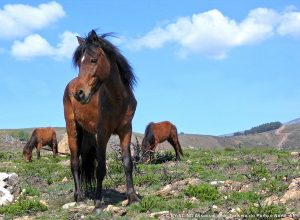
There are more than 100 unspoilt granite villages with traditional grain stores -“espigueros”- amidst the peaks, oak and pine forests, rivers and waterfalls. With thrilling flora and fauna, there are hiking trails from 1km – 30km, all signposted throughout the park. Mountain-biking is also popular and the Rio Caldo with its Albufeira de Canicada is great for water sports.
Vinho Verde – a true green delight!
Vines grow everywhere in the Minho, mostly upwards! – you will see them climbing up telegraph poles, oak trees, hedges, pergolas and porches, sensibly leaving ground space for other crops.
The reason – Vinho Verde! – a light, sharp, fruity and slightly fizzy young wine, low in alcohol content, produced only in the Minho. It makes a lovely refreshing drink served chilled as an aperitif or with seafood and fish. There are also reds and rosés, but the whites are what to go for…
The best are the “Alvarinhos” from Moncao and Melgaco which are slightly stronger and less spritzy. Be truly Portuguese and drink Vinho Verde from a “malga” – a white porcelain bowl.
The grape harvest -“vindimia”- takes place from mid-September through October, and is mostly done by hand – a fantastic sight to see. This is really a wonderful time to visit the region, to see cartloads full of grapes on the way to the bodegas.
Saude!
Things to See and Do in the Minho Region - Out and About
Valenca do Minho
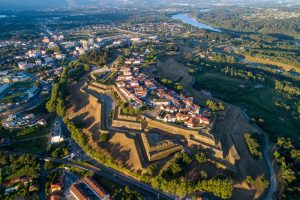
Now, in place of soldiers, the town is invaded by shoppers who come to buy towels and linen from the shops that line the cobbled streets (Wednesday, market day and weekends are particularly busy), but the old quarter within the walls with its medieval lanes and pretty squares is still worth a visit, and going up onto the ramparts, looking down onto river far below, makes you realise how difficult any invasion would have been.
With two interesting churches – Romanesque Santa Maria dos Anjos with a fine painted ceiling and C14th San Esteban with its neoclassical façade – and Manueline mansions, you’ll also find the original Roman milestone marking the route from Braga to Astorga in Spain and the statue of Sao Teotonio, the town’s patron saint and the first Portuguese saint.
Moncao
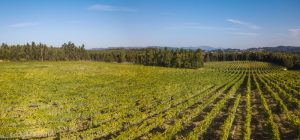
Culture aside, it also has a good choice of restaurants where you can sample Minho specialities at their best, including seasonal river eel and roasted kid.
The “cradle” of Alvarinho, the town celebrates a three-day fiesta in late May in honour of its wine, stages a reenactment of St. Geoge fighting the dragon on Corpus Christi and has a huge five day celebration in August for Nossa Senhora das Dores!
Should you want to buy the delicious Alvarinho wine, your best bet is at the Adega Cooperativa de Moncao, just south of the town.
A bit further south on the way to Arcos de Valdevez, the grand C19th Palacio de Brejoeira, with its Alvarinho vineyards as well gardens, is well worth a visit for a tour round the house and the estate and for wine tasting. Open: 9.30 – noon, 14.00 – 17.30 (Tues – Sun).
Melgaco
East of Moncao, Melgaco is another pretty fortress town on the River Minho, with a C12th castle and Romanesque monuments, a Friday market and again home to many battles!
The nearby Spa, Termas do Peso, is well known for the healing properties of its waters, while in the town itself is the old winery, bar and shop of Solar de Alvarinho, where you can taste and buy their superb wine.
With its fair share of family run restaurants, locals and visitors alike come specifically to Melgaco to feast on excellent traditional regional fare – try Adega Sabino in the town centre or Adega de Sossego at Lugar do Peso.
Soajo
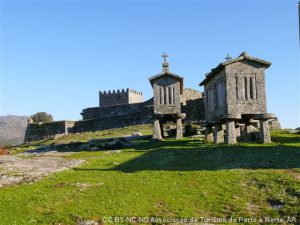
Lovely scenic walks can be had, giving you wonderful views and the chance to have a dip (on hot summer days) in one of the beautiful natural pools with crystal clear water.
Caminha
Caminha with its historic centre and ancient forest has an added interest in its quirky car ferry crossing to A Guarda in Spain and the fascinating Celtic settlement at Monte Sante Tecla which towers over the Minho and coastline.
Vila Nova de Cerveira
The lovely old town of Vila Nova de Cerveira has a biennial arts festival when colourful umbrellas float above the streets.
Atlantic Beaches and Praias Fluviais
Exhilarating windswept beaches all along the coast – Ancora, Afife, Cabadelo, Carreco, Foz de Minho, Moledo … great for surfing, kite surfing and windsurfing.
Lovely river beaches on the Rio Lima (Ponte da Barca, Arcos de Valdevez, Paredes de Coura) and the Rio Minho (Vila Nova de Cerveira).
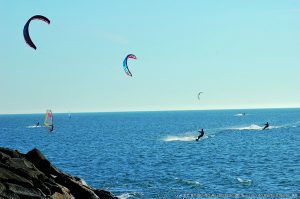
Serra D’Arga
The beautiful natural park of Serra D’Arga (southeast of Caminha) with its spectacular scenery, watermills, lagoons and flora and fauna, is great for walking and all sorts of outdoor activities.
Walk part or all of the pilgrim’s trail with numerous churches on the way from Ponte de Lima to the Sao Joao monastery in the Serra D’Arga.
River walks along the Rio Vez and Rio Lima
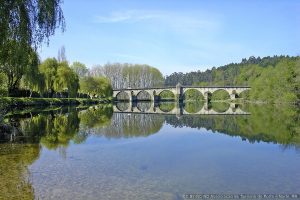
Don’t miss out on Bar Delfim in Arcos de Valdevez – a piece of history, with Delfim’s lifetime collection of accordions and other curiosities. If you are lucky, you might meet the master player himself there.
Thursday market at Barcelos
The charming ancient town of Barcelos on the River Cavado is home to that national icon, the Portuguese cockerel. It is particularly lively and atmospheric on Thursday market day, holding the oldest and largest market in the Minho – great for locally made pottery and other local handicrafts.
Bom Jesus do Monte
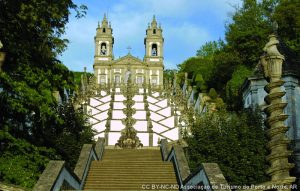
Just outside Braga is the magnificent pilgrimage site of Bom Jesus do Monte with its extraordinary baroque staircase – climb it on foot or take the funicular. Stunning views from the top. Camera a must! The Samiero Sanctuary further up the hill is well worth a visit too.

Citania de Briteiros
Fifteen kilometres north of Guimaraes , Citania de Briteiros is a Celtic hilltop settlement, the largest and most thrilling in Portugal, dating back 2500 years. Open: 9.30 – 18.00 (May – Sept) and 9.30 – 17.00 (Oct – Apr).
The Monastery of Tibaes
The Monastery of Tibaes, with its amazing natural gardens with centenarian trees, was the original home to the Benedictine order in Portugal. Founded in 1060, it has seen many changes (part of it is now a hotel) but, along with its Rococo church, it is a must-see visit.
Albufeira de Canicada
The stunningly beautiful Albufeira de Cancicada (artificial lake) (32 kms from Braga) on the Rio Cavado in the Peneda-Geres National Park is lovely just to drive around, but it is fantastic for water sports – kayaks, pedal boats, small motorboats and wakeboarding. There is also a good fluvial beach. Very popular in the summer months.
Eat and Drink in Minho Region
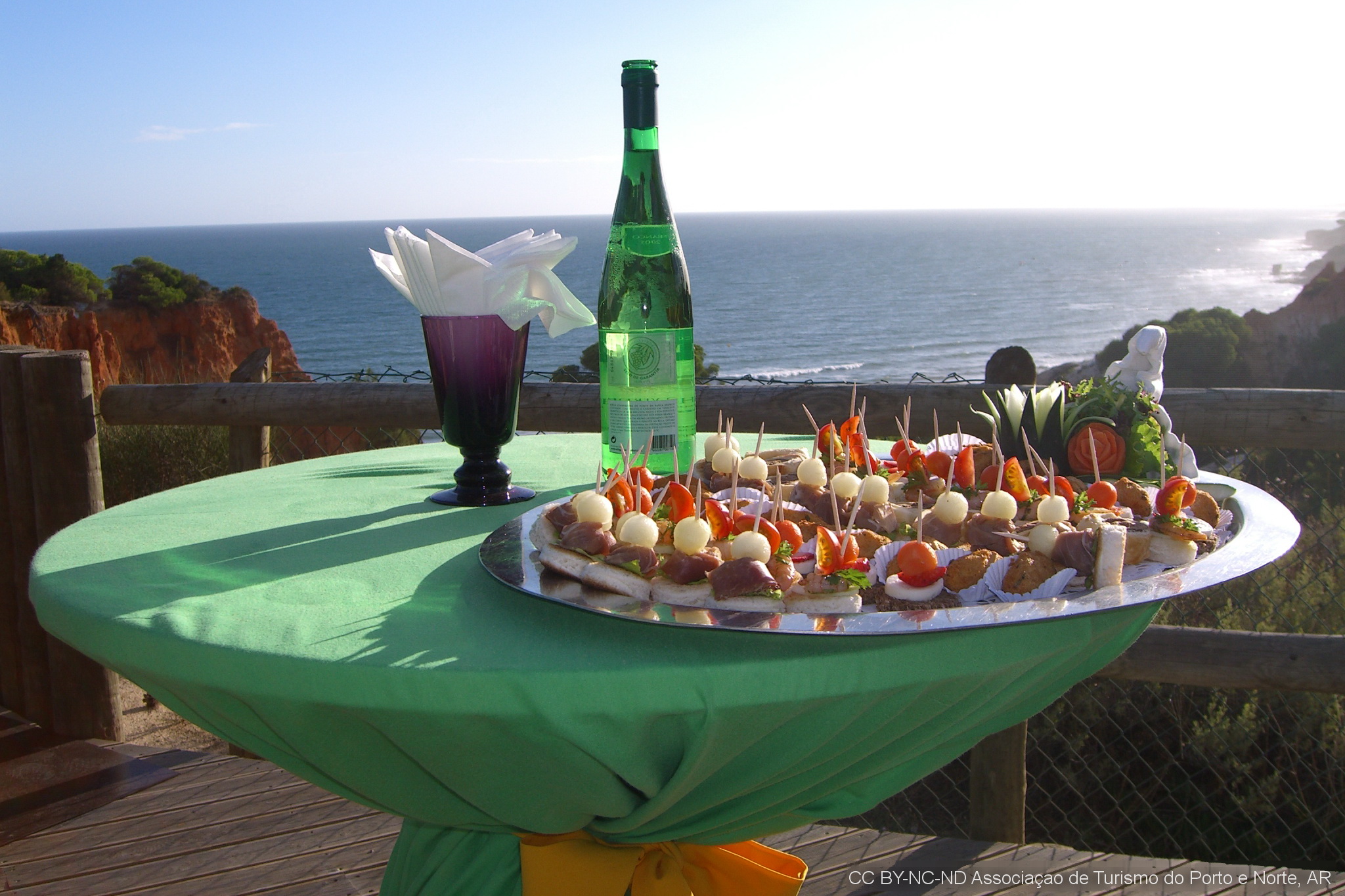
It is not surprising that the delightful region of the Minho in Northern Portugal was distinguished with the award of the European Region of Gastronomy in 2016. Here and in the rest of Portugal, the cuisine is still refreshingly regional, making best use of natural sources, employing quality ingredients, following simple but effective recipes, based on tradition, to create fresh and appetising dishes – hearty and tasty and pleasing to the eye.
The last few years have also seen an emergence of young cooks who with their creativity and imagination have added their innovative touches to a cuisine strongly linked to the past.
In the whole region, coastal and inland, there are countless family run restaurants, some still with their kitchen “on view”, so you can enjoy not only what is on your plate, but also the preparation of it, from freshly grilled sardines to heart-warming soups. Mostly at these establishments “prato do dia” (dish of the day) or “menu turistica ementa” (menu of the day) will be offered at lunchtime when dining rooms fill with workers and local businessmen alike. They certainly do not skimp on quantity here, but it is perfectly acceptable to order a half portion “meia dose” or share a whole portion “uma dose” between two.
Start with the region’s signature dish “caldo verde” (kale, potato and onion soup) or whet your appetite with the little dishes of olives, cheese, “presunto” (cured ham), “pasteis de bacalhau” (codfish croquettes), prawns…which nearly always appear on your table, even if not ordered. (They will appear on the bill at the end, but you can turn them away).
Then prepare for the freshest of Atlantic fish and seafood, juicy Barrosa (locally reared cattle) steaks, kid roasted in wood fired ovens, chicken grilled to perfection over coals, bacalhau (salt cod) cooked in as many ways as there are days in the year, rich pork casseroles… Main courses are usually accompanied by potatoes and rice and either a salad or cooked vegetables.
For the adventurous, you might be brave enough to try a Ponte de Lima dish, “sarrabulho” (a mixture of rich minced meats and pigs blood!) or “feijoas com tripas” (tripe and beans with rice) or the local delicacy “lampreia” (lamprey). The choice is yours!
Puddings, mostly egg and milk based, are simple, but delicious – “leite crème” (crème brulee), “pudim flan” (crème caramel), “arroz doce” (rice pudding) “pasteis de nata” (custard tarts) and “rabanadas do Minho” (French toast with honey and wine) to name a few.
For bread fans, the Minho, and Portugal in general, should be high on your list – at many restaurants you will be given a basket with a mixture of locally made breads – try “broa” – a type of corn bread – very more-ish. In the Minho, the region’s refreshing and delicious slightly sparkling white wine” Vinho verde” or “Alvarinho” will be on any restaurant’s wine list. There are reds too, but they can be too acidic, so for red it is best to stick to the wines from El Alentejo, the Douro or Dao where there are some superb choices.
As an aperitif, you might like to follow the local custom and try a glass of port – some of the red ports are much lighter than you find in England and the dry white ports are great to tease your appetite.
Should hunger strike between meals some bars offer “petiscos” (tempting little savoury snacks) and don’t miss out on a morning coffee (usually excellent) and a tempting cake or pastry at one of the many popular cafeterias.
Eating times
The Portuguese tend to eat early. Most restaurants start serving at noon and go on till 3.00 pm. In the evenings they usually open at 7.00 pm and stop serving at 11.
Frequently Asked Questions about Things to See and Do in Minho Region
How to get to the Minho Region?
Fly directly to Oporto / Porto and hire a car – the best options are:
- From London Gatwick: TAP Portugal or Easyjet
- From London Stansted: Ryanair
- From Liverpool: Ryanair
- From Manchester: Easyjet, TAP or Ryanair
- From Birmingham: Ryanair
- From Luton: Easyjet
- From Bristol: Easyjet
- From Dublin: Ryanair and TAP
PLEASE NOTE some flights are seasonal.
NB: Flights are not included
Alternatively you could fly to Lisbon (3 hours drive) or Santiago de Compostela in Spain (2hrs 30mins drive). Ask us about these.
Ferry: if you wish to bring your own car, classic car or motorbike we can include the ferry crossings as part of the package – please take a look at our PO7 Porto Run or ask for advice.
When to go to the Minho Region?
A visit to the Minho Region is best enjoyed in the Spring or the Autumn; from mid-March through to early July then from September through to mid-October when it enjoys a relatively gentle climate which supports the production of fine Vinho Verde wines.
Though a little cooler and more humid than other parts of the country, at the height of summer temperatures can often reach the low 30s Centigrade – so best avoided if you don´t like the heat ( with air-conditioning and a siesta it can be made possible, and it is all at its quietest).
How long to stay in the Minho Region?
We normally recommend at least two nights in each location when taken as part of a Portugal Touring Holiday though, if you have more time, there’s no end of things to see in the Minho Region. We offer accommodation in/near Viana do Castelo, Guimaraes and the Peneda-Geres National Park from where you can explore the region.
Don´t miss Braga with its Roman past and its magnificent pilgrimage site of Bom Jesus do Monte or Ponte de Lima, oldest town in Portugal.
What to eat in the Minho Region?
With vines growing everywhere in every shape and size, the refreshing young vinho verde wine, both white and red, goes down well with the hearty, tasty and unpretentious local cuisine – from the freshest of fish and seafood at the fisherman’s quarter in Viana do Castelo to roasted kid in a mountain village. Family restaurants abound and there are more sophisticated ones too for a special treat.
What to buy in the Minho Region?
In the Minho Region, like in any other travel destination, you will find plenty of souvenir shops selling all kind of typical bric-a-brac as well as authentic pressies. From small family-run businesses to long-established markets, there is a lot to choose from!
The local light, sharp, fruity and slightly fizzy young vinho verde is certainly a safe bet if you are wine lover. You can acquire it anywhere you go in the country, but don´t miss the opportunity and grab a bottle during you visit to Melgaco or Moncao.
A symbol of Portuguese culture, the colorful Barcelos ceramic rooster is a very popular souvenir originating in the village of Barcelos. It represents good luck, joy and prosperity. It is conveniently found in various sizes, so you can choose yours depending on your luggage limitations.
Filigree jewellery and embroidery is another interesting option if you are looking for something a bit more luxurious. Traditional Portuguese jewelry is markedly religious with the Coração De Viana (Heart of Viana) as one of the most traditional motif from the region representing life, friendship and love.
Cork-based products are also worth considering. Being Portugal the main cork producer in the world, there are several handcraft worshops producing and wide variety of accessories. Bags, purses, wallets, belts or even hats, they are both unique and sustainable.
And last but not least, embroidered linens, local cheeses, chocolate and pastries or even fado music CDs are a safe bet for the loved ones!


